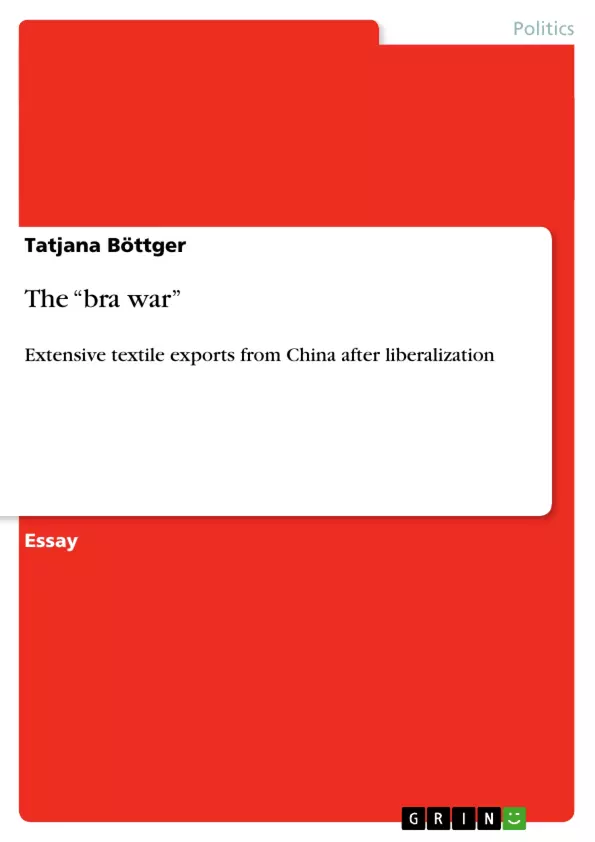This essay is going to examine the recent troubles about immensely increasing textile exports from China into the European Union, which were also called the “bra war”. After the liberalization in that area since the beginning of this year, the EU felt it needed to guard its textile industry from cheap Chinese imports and set up protectionist measures in summer, which meant that a huge amount of textiles stuck at the customs. A solution was only found in September. The questions which will be addressed in that essay are: What has led up to that situation? What is the legal and economic background? Which kind of trade policy is in the best interest for the European Union?
Inhaltsverzeichnis (Table of Contents)
- Introduction
- What has happened in detail?
- What has led up to this situation?
- What is the legal and economic background?
- What does that mean for EU trade policy?
- Sources
Zielsetzung und Themenschwerpunkte (Objectives and Key Themes)
This essay examines the "bra war", a dispute regarding textile exports from China to the European Union. The essay aims to understand the events leading up to this situation, explore the legal and economic background, and consider the implications for EU trade policy.- Liberalization of the textile market
- The impact of Chinese textile imports on European industry
- The role of trade policy in balancing free trade with industry protection
- The EU's response to increasing Chinese textile imports
- Negotiations and compromises between the EU and China
Zusammenfassung der Kapitel (Chapter Summaries)
- Introduction: This chapter introduces the "bra war" dispute, which arose from the unexpected increase in Chinese textile imports following the liberalization of the textile market. It outlines the EU's dilemma between free trade and industry protection and the compromise solution reached at the EU-China summit.
- What has happened in detail?: This chapter details the events leading up to the "bra war", including the liberalization of the textile market in 2005, the subsequent surge in Chinese textile imports, and the EU's introduction of import quotas. It also describes the resulting uncertainty and difficulties for importers and producers.
- What has led up to this situation?: This chapter explores the historical context and factors that contributed to the situation. It discusses the rapid growth of the Chinese economy, the role of the GATT and WTO agreements in liberalizing trade, and the exclusion of textiles from these agreements. The chapter also mentions the Multifibre Arrangement (MFA) and its impact on textile trade.
Schlüsselwörter (Keywords)
This essay focuses on the "bra war" and its implications for European trade policy. Key terms include: textile trade, liberalization, import quotas, free trade, industry protection, EU-China relations, WTO, GATT, Multifibre Arrangement (MFA), and China's economic growth.- Citation du texte
- Tatjana Böttger (Auteur), 2006, The “bra war”, Munich, GRIN Verlag, https://www.grin.com/document/132612



